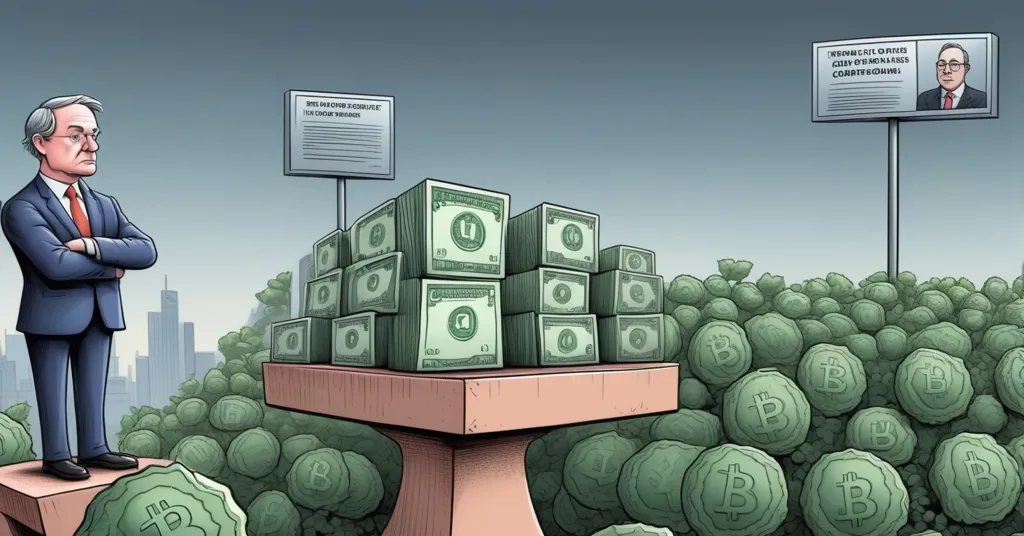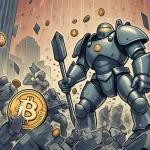Fed’s Powell Signals Patience Amid Tariff Hikes, Impacting Crypto Markets

Fed’s Powell Stays Patient Amid Tariff-Induced Economic Uncertainty
Federal Reserve Chair Jerome Powell has announced a patient approach in response to President Donald Trump’s recent tariff hikes, signaling that the central bank will not rush to intervene as it did during the global economic crisis.
- Fed remains patient despite tariff hikes
- Robust labor market vs. inflation concerns
- Market expectations for rate cuts diminish
Speaking in Arlington, Virginia, Powell emphasized the Fed’s intention to wait for clearer economic indicators before making any policy decisions. This cautious stance comes amidst a complex economic landscape where a robust labor market contrasts with the looming threat of inflation due to tariffs. Powell’s comments reflect a deep awareness of the economic forces at play, as he noted,
“There’s a lot of waiting and seeing going on, including by us.”
He further emphasized the Fed’s patience, stating,
“We’re going to need to wait and see how this plays out. It feels like we don’t need to be in a hurry. It feels like we have time.”
The March jobs report showcased economic resilience, with a rise of 228,000 in non-farm payroll employment and the unemployment rate holding steady at 4.2%. However, the shadow of Trump’s tariffs looms large, potentially pushing the average tariff rate on U.S. imports from 2.5% to as high as 25%. This move has raised serious concerns about inflation and economic growth, with fears that the economy could be headed towards stagnation or worse. For those new to economic terms, “non-farm payroll” refers to the total number of paid workers in the U.S. excluding farm workers, government employees, and some other groups, while “stagflation” is a situation where the economy experiences stagnant growth and high inflation simultaneously.
Market expectations for a rate cut at the Fed’s upcoming May 6-7 meeting have significantly dropped from 50% to 30% following Powell’s remarks. This shift is mirrored in the decentralized betting platform Polymarket, where 56% of participants believe there will be no rate cuts in May. A “Fed put” is the expectation that the Federal Reserve will intervene to support the market during downturns, and Powell’s cautious approach has recalibrated these market sentiments, reflecting the uncertainty and complexity of the current economic situation.
Economic forecasts from JPMorgan paint a grim picture, predicting a 0.3% contraction in the U.S. economy this year, with unemployment expected to rise to 5.3% by year’s end. Inflation, driven by the tariffs, is expected to exceed the Fed’s 2% target by at least a percentage point, adding to the central bank’s challenges. Powell acknowledged the uncertainty surrounding monetary policy decisions, stating,
“It’s not clear at this time what the appropriate path for monetary policy is.”
The Fed’s primary concern remains anchored on inflation, with Powell stressing,
“Our obligation is to keep longer-term inflation expectations well anchored. We need to ensure that a one-time increase in the price level does not become an ongoing inflation problem.”
He also highlighted the dual impact of tariffs, saying,
“The effects at the margin right now would be higher inflation and perhaps higher unemployment. That’s difficult for a central bank.”
Drawing parallels to past economic challenges, Powell noted,
“We’re not in a situation like we were in the 1970s. But the risks at the margin today do point in that direction.”
As the Fed navigates these turbulent economic waters, the broader implications of Trump’s tariff policies continue to unfold. The potential for stagflation looms large, reminiscent of the economic challenges faced in the 1970s. The global impact of these policies is evident, with stock markets worldwide reacting to the uncertainty. While some may find the Fed’s cautious approach frustrating, it reflects a commitment to its dual mandate of maximizing employment and stabilizing prices.
In the world of cryptocurrencies, where decentralization and freedom are championed, the Fed’s actions are closely watched. Bitcoin and other cryptocurrencies often serve as a hedge against traditional economic uncertainties, and Powell’s patient stance could influence investor sentiment in these markets. While Bitcoin maximalists might argue that cryptocurrencies are the future of money, it’s important to recognize that other blockchains and altcoins also play crucial roles in the financial revolution, filling niches that Bitcoin might not serve as effectively.
As we wait for clearer economic indicators, the world watches, hoping for a resolution that can steer the economy away from the brink of a potential downturn. In the meantime, the crypto community remains vigilant, ready to adapt to whatever economic shifts may come.
Key Takeaways and Questions
- What is the Federal Reserve’s current stance on monetary policy?
The Federal Reserve, led by Jerome Powell, is adopting a patient approach and will not intervene immediately in response to recent tariff hikes. Powell emphasized the need to wait for clearer economic indicators before making any policy decisions.
- How have recent tariff hikes affected market expectations for a “Fed put”?
Market expectations for a “Fed put” have been dampened, with the odds of a rate cut at the Fed’s upcoming meeting dropping from 50% to 30% following Powell’s remarks.
- What are the potential economic impacts of Trump’s tariff policies?
Trump’s tariff hikes could increase the average tariff rate on U.S. imports significantly, potentially leading to higher inflation and slower economic growth. There are concerns about the economy moving towards stagnation or worse.
- What are the current economic forecasts for the U.S. economy?
JPMorgan economists predict a 0.3% contraction in the U.S. economy this year, with the unemployment rate expected to rise to 5.3% by year’s end. Inflation is expected to be pushed at least a percentage point above the Fed’s 2% target due to tariffs.
- How does the current economic situation compare to historical economic challenges?
Jerome Powell noted that while the U.S. is not currently in a situation like the 1970s, which saw high inflation and unemployment (stagflation), the risks at the margin today do point in that direction due to the potential impacts of tariffs.



